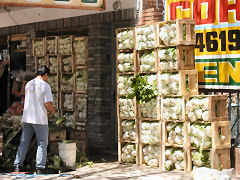 Buenos Aires – My Everquest friends will know the allusion of the title. Back in the day, before the game expanded like a muffin climbing out of its cup, Protection of the Cabbage was a druid spell that one spent eons working on getting a copy of, well in advance of ever needing it, but the “quest” was the thing. And the spell itself, down the line, was one of the more important “buffs” in the game, and had absolutely nothing to do with cabbages. Those days are gone, as it has been replaced by this, that, and the other, such is life in fantasy land. But there I was yesterday, my friend Max having wanted to check out Coreatown, and suddenly all I could think of was the spell.
Buenos Aires – My Everquest friends will know the allusion of the title. Back in the day, before the game expanded like a muffin climbing out of its cup, Protection of the Cabbage was a druid spell that one spent eons working on getting a copy of, well in advance of ever needing it, but the “quest” was the thing. And the spell itself, down the line, was one of the more important “buffs” in the game, and had absolutely nothing to do with cabbages. Those days are gone, as it has been replaced by this, that, and the other, such is life in fantasy land. But there I was yesterday, my friend Max having wanted to check out Coreatown, and suddenly all I could think of was the spell.
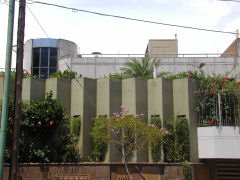 I must say that the area is much prettier in sunshine, but that’s true of many places. Like the last time I visited, the community remains fairly insular. Doors are locked, and being amongst the few white boys in the neighborhood, we were the object of suspicious glances and glares. This time I got the chance to wander a bit more. Interestingly, though the main commercial street of Carabobo is fairly run down, as soon as you step off of it into the residential area to the north you find well kept homes, many in quite modern styles.
I must say that the area is much prettier in sunshine, but that’s true of many places. Like the last time I visited, the community remains fairly insular. Doors are locked, and being amongst the few white boys in the neighborhood, we were the object of suspicious glances and glares. This time I got the chance to wander a bit more. Interestingly, though the main commercial street of Carabobo is fairly run down, as soon as you step off of it into the residential area to the north you find well kept homes, many in quite modern styles.
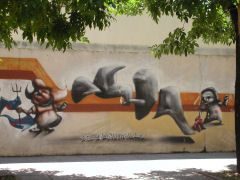 Here and there we found bits of graffiti, though most of it not just straightforward “tags.” Futuristic and fantasy scenes seem to be the motif, and some of them are quite well done and almost seem like they belong there. Perhaps they were commissioned… We spent a good hour or more wandering the streets and looking at buildings and homes, finding interesting little things like one home that offers a “private spa” service. We didn’t stop and ask.
Here and there we found bits of graffiti, though most of it not just straightforward “tags.” Futuristic and fantasy scenes seem to be the motif, and some of them are quite well done and almost seem like they belong there. Perhaps they were commissioned… We spent a good hour or more wandering the streets and looking at buildings and homes, finding interesting little things like one home that offers a “private spa” service. We didn’t stop and ask.
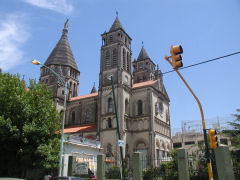 At one point we found ourselves walking along Avenida Asamblea, and from a little bit away spotted this large cathedral looking building. It turned out to be Nuestra Señora de la Medalla Milagrosa, or at least that seems to be what it’s listed as officially. Up close and personal, it purports to be the Santería “El Santuario”. Now, I know little about catholicism in general, and even less about santería. My understanding is that this particular branch of catholicism is centered around the worship of saints, and that it comes from a symbiotic relationship between west African tribal religions and conversion to catholicism. Somehow that seems to be outside of the tenets of catholicism, though I guess that depends on exactly what is meant by “worship,” and I guess it is really no different in some ways than the multiple virgenes that I’m encountering with the descendants of the various Incan, Quechuan, and other tribal folk who were converted by the Spanish several centuries ago.
At one point we found ourselves walking along Avenida Asamblea, and from a little bit away spotted this large cathedral looking building. It turned out to be Nuestra Señora de la Medalla Milagrosa, or at least that seems to be what it’s listed as officially. Up close and personal, it purports to be the Santería “El Santuario”. Now, I know little about catholicism in general, and even less about santería. My understanding is that this particular branch of catholicism is centered around the worship of saints, and that it comes from a symbiotic relationship between west African tribal religions and conversion to catholicism. Somehow that seems to be outside of the tenets of catholicism, though I guess that depends on exactly what is meant by “worship,” and I guess it is really no different in some ways than the multiple virgenes that I’m encountering with the descendants of the various Incan, Quechuan, and other tribal folk who were converted by the Spanish several centuries ago. 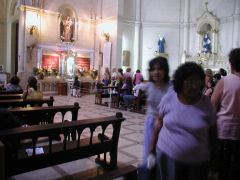 What we found on entry was a series of a couple of dozen primarily small shrines, each housing a statuette (most not much more than a foot or so tall) of a different saint. The place was crowded, and people were entering and heading straight for one saint or another’s shrine, and then spending time touching the statue, holding it, praying to or at it, here and there a bit of weeping. The largest shrine was to San José, and this one had a lineup of a few dozen people waiting for their individual turn with him. For me it seemed, in some ways, no more strange than the rest, to Max, who is catholic, he said it was the first time he’d ever seen such a thing.
What we found on entry was a series of a couple of dozen primarily small shrines, each housing a statuette (most not much more than a foot or so tall) of a different saint. The place was crowded, and people were entering and heading straight for one saint or another’s shrine, and then spending time touching the statue, holding it, praying to or at it, here and there a bit of weeping. The largest shrine was to San José, and this one had a lineup of a few dozen people waiting for their individual turn with him. For me it seemed, in some ways, no more strange than the rest, to Max, who is catholic, he said it was the first time he’d ever seen such a thing.
 By this point we were hungry, so we stopped in at the first little place we saw open. No one else was there, and the proprietess greeted us with a sort of “what do you want?” Max happens to be vegetarian (these things just seem to happen to some people), and he asked if she offered anything that would fit. It was actually sort of amusing watching her facial expressions as she clearly reviewed the entire menu in her head for about ten seconds, finally announcing that she couldn’t really think of anything, “Koreans like meat” was her final pronouncement. She had no other options to offer, so we headed to the next place down the line. We decided just to take a seat in the narrow but busy space at Una Canción Coreana, Carabobo 1547. Like the last time I ate in the neighborhood the Koreans at the tables looked at us like we were from outer space.
By this point we were hungry, so we stopped in at the first little place we saw open. No one else was there, and the proprietess greeted us with a sort of “what do you want?” Max happens to be vegetarian (these things just seem to happen to some people), and he asked if she offered anything that would fit. It was actually sort of amusing watching her facial expressions as she clearly reviewed the entire menu in her head for about ten seconds, finally announcing that she couldn’t really think of anything, “Koreans like meat” was her final pronouncement. She had no other options to offer, so we headed to the next place down the line. We decided just to take a seat in the narrow but busy space at Una Canción Coreana, Carabobo 1547. Like the last time I ate in the neighborhood the Koreans at the tables looked at us like we were from outer space.  The two women who were clearly the proprietors ignored our existence completely. We sat for close to ten minutes (we were determined…) and finally the cook, who is, I’d guess, Bolivian, popped out from the kitchen, having peered at us once or twice. He was friendly, helpful, and assured us he could whip something up without any meat for Max; after all what more could be asked for from a place which he said roughly translates as Casa Alegre, or the Cheerful House. Unfortunately, despite his good intentions, this lovely (though bland) dish of rice with vegetables, egg, and shrimp, was his interpretation of meatless. Max made the best of it, eating around the shrimp, but I ended up bringing it home and recooking it later with some seasoning for a snack.
The two women who were clearly the proprietors ignored our existence completely. We sat for close to ten minutes (we were determined…) and finally the cook, who is, I’d guess, Bolivian, popped out from the kitchen, having peered at us once or twice. He was friendly, helpful, and assured us he could whip something up without any meat for Max; after all what more could be asked for from a place which he said roughly translates as Casa Alegre, or the Cheerful House. Unfortunately, despite his good intentions, this lovely (though bland) dish of rice with vegetables, egg, and shrimp, was his interpretation of meatless. Max made the best of it, eating around the shrimp, but I ended up bringing it home and recooking it later with some seasoning for a snack.
 Meanwhile, I’d asked for something mildly spicy, and he’d recommended his calamari soup. It was quite good, just a little bit spicy, as advertised, and full of mixed vegetables and squid, and a solitary clam adorning the top. He had also just finished making a couple of trays of steamed pork dumplings, so I ordered a plate, figuring I’d eat a couple (8 to an order) and bring the rest home for later as well. They were quite good as well – the dough light and airy, and given its translucency, I’d guess made from rice flour rather than wheat. All in all a pleasant meal, though I think we’ll have to keep searching for something that qualifies as meatless.
Meanwhile, I’d asked for something mildly spicy, and he’d recommended his calamari soup. It was quite good, just a little bit spicy, as advertised, and full of mixed vegetables and squid, and a solitary clam adorning the top. He had also just finished making a couple of trays of steamed pork dumplings, so I ordered a plate, figuring I’d eat a couple (8 to an order) and bring the rest home for later as well. They were quite good as well – the dough light and airy, and given its translucency, I’d guess made from rice flour rather than wheat. All in all a pleasant meal, though I think we’ll have to keep searching for something that qualifies as meatless.
After lunch we headed back to the wall of cabbage to buy some fun things to play with later… more in the next post.
[…] SaltShaker Casting a little flavor (and a few aspersions) on the world of food, drink, and life Blog HomeSaltShaker Main Page :: Who Am I?My Bio :: Contact me via e-mail Bigger Font Size Smaller Font Size Left Align Justify Align Right Align Bookmark This Page Print This Page « Protection of the Cabbage […]
[…] here are a few relevant links we came across:http://randompanda.blogspot.com/2008/08/korea-town-barrio-coreano.htmlhttps://www.saltshaker.net/20060128/protection-of-the-cabbagehttp://www.tableconversation.com/2008/09/korean-food-in.html […]
Just a caution….